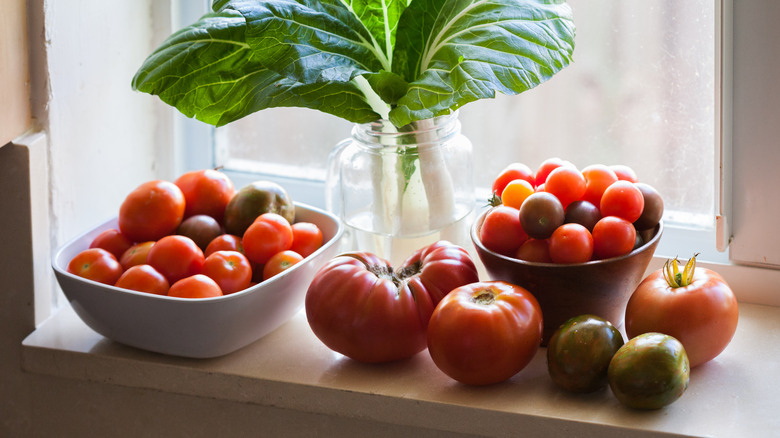The Gardening Myth About Ripening Tomatoes That Might Just Work, According To House Blog's Master Gardener
We find comfort in absolutes: the sky is blue, the grass is green, and cats are the best pet. Ok, maybe that last one is not an absolute, but neither are many aspects of gardening. In fact, the answer to most gardening questions is, "Well, it depends..." The best way to ripen tomatoes is no exception. While there is a myth that the best place to ripen green tomatoes is a sunny windowsill, the best option actually depends on the ripening stage of the tomato.
There are many ways to ripen tomatoes indoors, all of which you can do once the fruit starts to blush. This is when you start to see a hint of color, usually starting at the blossom end. Before this point, tomatoes cannot produce the ethylene gas necessary to complete the ripening process. But once that ethylene production starts, you can ripen your tomatoes indoors in the way that works best for you. Before we dive into that, let's talk about the stages of tomato ripeness.
Stages of ripening tomatoes
There are six stages of tomato ripeness between totally green and ready to eat. The first stage is the green mature stage when the tomato has finished growing, but there is no color on the outside of the fruit. They are still very firm and lack significant tomato flavor. At this stage, the fruits are too immature to ripen indoors and will likely rot before they can ripen for fresh eating.
The next step in maturity is the breaker stage. This is the point at which the tomato is considered "vine ripe" and starts producing ethylene gas. These blushing tomatoes can be harvested and brought indoors to ripen. Once the fruit reaches the breaker stage, they have formed a thick skin on the stem which prevents them from absorbing any more nutrients from the tomato plant. This means there really is no benefit to leaving them outside. There is only the risk of damage from pests or environmental conditions. Sunlight is not required for the ripening process at this point. The remaining four stages are simply the process of the tomato continuing to ripen until it reaches at least 90% of its full color and is ready to eat.
Reasons to harvest tomatoes early
Before we dive into the "hows" of ripening tomatoes indoors, let's discuss the "whys." Since the tomato is vine ripe at the breaker stage, whether you ripen them indoors or leave them on the plant is totally up to you, but there are some things to consider. At this point, it is ethylene gas that causes fruits to mature, not sunlight. Your successful harvest is between you and mother nature.
Leaving tomatoes on the vine to mature leaves them susceptible to disease and pests. Late blight affects plants and their fruits, while too much or too little rain can cause tomatoes to crack. Pests that can get into tomatoes can include anything from insects to squirrels. Have you ever seen a squirrel run across your yard with an almost perfect tomato? We have. It's maddening. If you bring your toms in to ripen, you will not have to worry about any of this pestilence affecting your harvest.
If you are facing an early frost, the only way to salvage your tomatoes is to harvest them before the cold hits. Although you cannot fully ripen tomatoes when they are harvested in their first stage, they still make fried green tomatoes or canned pickles. When you are harvesting before a frost, separate your mature green tomatoes from those that have begun to blush so you can store them properly.
Ways to ripen tomatoes indoors
Although we have busted the myth that a sunny windowsill is required to ripen tomatoes, we can also acknowledge that it's not a bad option. Those of us who have a nice window above our kitchen sink can benefit from putting our tomatoes there because it's easy to check them every day. This myth that a sunny windowsill is required may simply have come from watching generations of mothers and grandmothers doing this very thing. Having ripening tomatoes in a visually accessible spot ensures we can watch for signs of rot and enjoy them when they reach peak ripeness.
Tomatoes that are harvested in early stages benefit from being confined in a smaller space where their production of ethylene gas can speed up the ripening process. You can place them in a paper bag or cardboard box after they start to blush. Place your tomatoes in any room temperature space where you will remember to check them often for signs of rot. Once they get close to being ripe, place them on a windowsill or countertop so you can watch them reach ripeness and enjoy them before they go bad. Never refrigerate tomatoes. The cold damages their tender tissues, leaving you with a tasteless fruit – and you have worked too hard for anything less than ideal tomato flavor.



